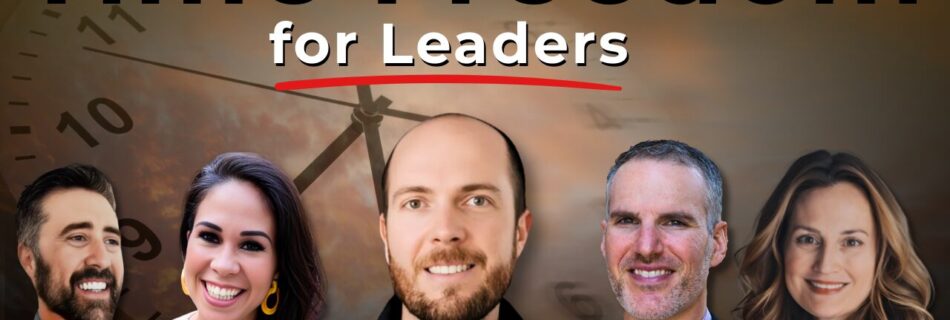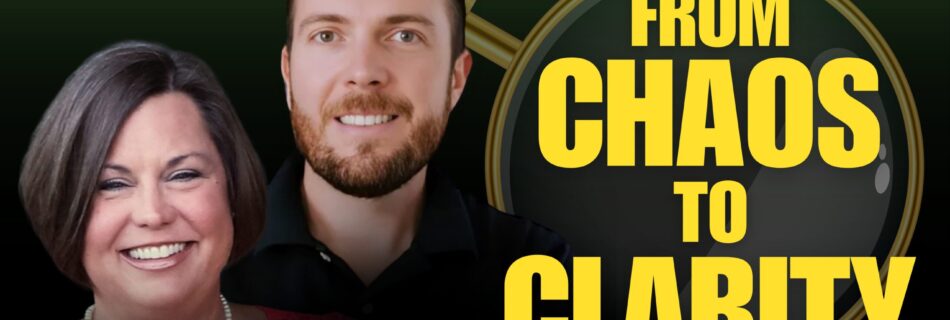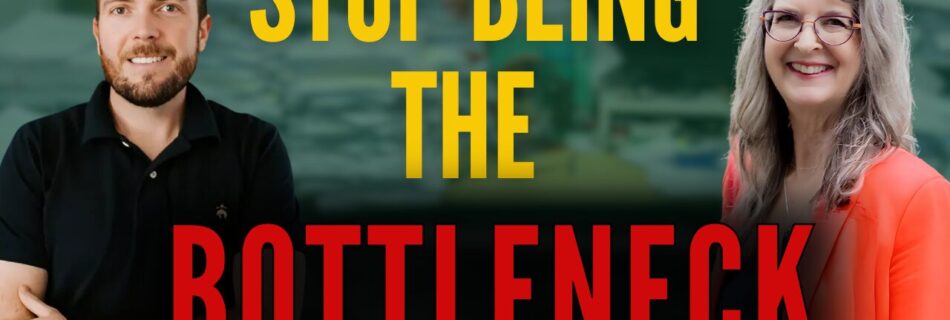How to Scale Your Business Without Burning Out: Lessons from the Executive Edge Live Panel
Fast growth is exciting—until it starts to cost you your health, your team, or your culture.
If you’re a founder or executive scaling quickly, this blog is your wake-up call and roadmap rolled into one.
Preferred listening on the go? Catch the full podcast episode on Spotify and Apple Podcasts.
Harley Green hosted a powerhouse session on the Scale Smart Grow Fast podcast:
🎙️ Executive Edge Live Panel, featuring:
- Bethany LaFlam – Author of The Power of OPE, Investor, & Attorney
- Christopher Filipiak – Sales Strategist & CEO Coach
- Alyshia Kisor-Madlem – VP of People & Systems, Found Search Marketing
- Saima Geelani – Core Energy Coach, Founder of Talent Edge World
🔥 The Core Takeaways for High-Growth Leaders
1. Growth Without Alignment = Guaranteed Burnout
Bethany LaFlam emphasizes that scaling without clearly defined goals, values, and personal alignment results in setbacks, misdirection, and emotional drain. “If it feels misaligned, it probably is.”
2. Your Energy Is Your Biggest Asset
Saima Geelani explains how invisible drains like unclear boundaries and internal “gremlins” (self-limiting beliefs) lead to burnout. She recommends core energy leadership and micro-recovery practices to maintain momentum.
3. Letting Go Is a Leadership Superpower
Alyshia Kisor-Madlem shares real-life experience from scaling agency teams. The difference between heroic contributors and sustainable systems? Documentation, delegation, and trusting your team before you hit crisis mode.
4. Sales Starts with the CEO—But Shouldn’t End There
Christopher Filipiak reframes sales as a leadership responsibility rooted in mindset, not just tactics. When CEOs align with sales emotionally and operationally, they stop being bottlenecks—and start leading scalable systems.
5. Protect Team Morale with Transparency
Your team isn’t just watching what you say—they’re filling in the blanks when you don’t say anything. Clear, consistent communication protects morale and builds buy-in.
💡 Real Growth Feels Energizing—Not Exhausting
Whether you’re a solopreneur adding your first team member or a CEO managing multiple departments, these insights are a must-know.
This isn’t just about growth—it’s about building something that lasts without losing yourself or your people along the way.
📬 Connect with the Panelists:
- Bethany LaFlam: Instagram @bethany_laflam
- Christopher Filipiak: Website | LinkedIn
- Saima Geelani: Website | LinkedIn
- Alyshia Kisor-Madlem: LinkedIn
📈 Bonus: Access our masterclass on sustainable scaling:https://workergenix.com/bonus-masterclass
✅ Ready to Scale Without the Stress?
If you’re serious about scaling smart—not just fast—your next move isn’t another 12-hour workday. It’s getting the right support system behind you.
Book a free discovery call with Workergenix to get matched with your Ultimate Executive Assistant—so you can scale faster without burning out.
Like what you read? Get weekly insights on scaling, efficiency, and profitability—straight to your inbox. Click here to subscribe.Transcript
Harley Green: All right, everybody, welcome to the Executive Edge live panel. I’m Harley Green, founder and CEO of Workergenix, where we help business leaders scale faster and smarter with the very best AI-leveraged executive assistants. This month’s panel is all about one of the biggest challenges business leaders face, growing fast without sacrificing your health, your team, and your culture. Sustainable growth, it’s not just a strategy, it’s really a leadership test. And today we’re gonna dive deep into the real mechanics of scale.
You’ll hear strategies, honest stories, and tangible frameworks from leaders who have been there and done that without the burnout. And a quick heads up, today’s session is also going to be featured on our podcast, Scale Smart Grow Fast. So if you hear something that hits home, you’ll be able to replay it later on Apple, Spotify, and YouTube. So today, let’s go ahead and dive in and meet today’s incredible panel.
First, we’ve got Bethany LaFlam, an attorney, investor, and bestselling author. Bethany helps entrepreneurs scale their wealth and freedom through strategic leverage, not burnout. She’s the author of The Power of OPE and leads a global movement to build aligned extraordinary lives.
Christopher Filipiak, sales consultant and coach. He works with CEOs of expert-based businesses to 12x growth through mindset and sales alignment. His integrated approach helps leaders add over a million dollars in revenue without losing control or energy.
We also have Alyshia Madlem, the VP of People and Systems, Found Search Marketing. With over 20 years in marketing agency leadership, Alyshia has scaled teams through acquisition and built operational systems that protect culture while driving performance.
And finally, last but not least, we’ve got Saima Geelani, founder of Talent Edge World. Saima is a globally experienced coach and HR leader who helps executives lead with clarity, energy, and purpose. Her core energy coaching framework builds leadership that sustains both performance and well-being. Welcome, everyone, to the panel.
Let’s start here. What does sustainable scale mean to you? And why do so many leaders get it wrong?
Saima Geelani: For me, sustainable scale is really like increasing the productivity of the organization while not losing focus on the energy, on the clarity and above all, the well-being of the people. What happens mostly when leaders get it wrong is when they primarily focus on the productivity, they focus on the numbers, they focus on the metrics. That’s absolutely fine, there is nothing wrong about it. But the problem is while doing so, they lose focus primarily on the well-being of the people.
Recently, I had gone through this book, Leaders Eat Last by Simon Sinek, where he says that when we ask the CEO what is your priority, they usually say customers. That might be true for small companies, but as the companies scale up, they grow bigger and that connection becomes smaller and eventually it becomes zero. So what is the truth here? The truth is CEOs or the leaders are responsible for the people and people eventually take care of your customers. So you really have to start backwards. That is where leaders really get it wrong.
Alyshia Kisor-Madlem: I think to build on that, often the focus is on numbers where people say, “I want to grow margin to something,” or “I want to grow year over year.” They lose the purpose. They lose who they are. They lose the connection to mission, vision and values. That’s what drives purpose and why. That’s what gets people to put in the time it takes to achieve those new margins and growth.
It starts to be this focus on hitting a numerical value instead of looking at the full growth journey—growing people or growing services or whatever it is you provide. You lose the connection to why you started or what you’re doing. People get disengaged and you start to see that downtrend very quickly.
Bethany LaFlam: I love that we’re having this conversation because I think too often we focus on the numbers and not on the people who get us there. The biggest thing for scaling, of course, is to leverage other people. I wrote a whole book on it. I specifically say leverage and not use because we want to make sure that we’re building up those people. It’s only sustainable if it’s a win for everybody. Everyone that’s helping you get to your vision and your dream—it has to help them get to theirs. It’s got to work for everybody. We lose sight of that when we focus just on the numerical metrics.
Christopher Filipiak: When you’re thinking about doing something sustainably, it means you can do it for a long time and it doesn’t eat away at your base-level resources. As you grow your company, or grow anything or grow yourself, you have more of something, not less. That’s the kind of growth we want.
It’s about developing the skill sets in your organization around change and growth. How can you build a culture that embraces and has the skills required to continually change and grow? When you develop that as a competency, that’s going to create sustainability in the people and in the organization as a whole.
Harley Green: Great insights there. I’m excited to dive into some of the things you all said. Bethany, you write about Aligned Living. What’s the cost when founders scale misaligned and how can they catch that early?
Bethany LaFlam: I think the biggest cost is misalignment in your business, which could mean a number of things. If it’s not driving toward a stated goal or big vision, that’s a problem. People get this wrong a lot. They don’t state the goal. They’re busy running a business and they’ll figure it out later. But if you’re just working to work and you don’t really know where you’re headed, that’s going to lead to misalignment.
You end up growing for the sake of growth, but it’s not scalable or sustainable. Then you find yourself being pulled back—one step forward, two steps back. If you’re not aligned, you are going to backslide. It’ll take longer to get to your goal. Either you haven’t identified it, or you have people outside their lanes. Entrepreneurs are notorious for trying to do all the things.
How can you catch it early? Stop quieting that voice, that inner knowing. I know it doesn’t seem logical, and it seems really soft. But especially as women, we’ve been conditioned to quiet that voice down. If it feels misaligned, it probably is. Trust that. Recalibrate. That feeling is just as important as the data. If something is painful, your job is to figure out how to make it not painful. Anyone who says it just has to suck for a really long time—don’t listen to that. It doesn’t. Your job is to get through the suck as fast as possible and actually enjoy your life.
Christopher Filipiak: That’s a really interesting awareness. As you grow your business and yourself, there’s good and bad in everything. One person’s “suck” could be another person’s passion. Alignment comes from being aware of that and choosing where to put your focus. If you’re not in love with your work or your business, you’re going to self-sabotage. You’ll spend more time in the suck than in the love.
Bethany LaFlam: The biggest obstacle is our mindset. I’ve spent hundreds of thousands on coaching just to shift my mindset and remind myself—I get to do the things I love because I said so.
Saima Geelani: I agree. From a coaching perspective, it’s about listening to your inner self—your inner “who.” That’s where the magic happens. That’s where you find your passion and energy.
Harley Green: Christopher, you coach CEOs through high-stakes sales growth. How do you help them expand revenue without becoming the bottleneck?
Christopher Filipiak: It’s about understanding what sales really is. You started a business, and sales is a part of that. But sales is also an expression of love and service. There’s a mindset component to it: mastering your own sales work as the CEO. No resistance to strangers, no resistance to sales, no limiting beliefs around money. You need awareness around those things so they don’t stop you.
Once you’re aligned with sales and money, you start selecting strategies, behaviors, and teammates based on cause and effect—not fear, worry, or doubt. That creates flow. And that frees you up from being the bottleneck.
Alyshia Kisor-Madlem: I’d add to that. As operators, we help visionary CEOs get what’s in their head out into the world. Once you start selling, you need others to understand what you do so you’re not the only person who can do the job. At some point, someone else has to get it too. CEOs need to figure out what only they can do, what they can train others to do, and what they can let go of.
Sometimes, it’s about having trusted people around you—employees or advisors—who can say, “You can’t keep doing it all.” Let go. Build trust. Surround yourself with people who can scale the mission without making it all about you.
Christopher Filipiak: Exactly. Build the skills and strategies into the business, not just into one person. As you do that, the CEO is free to do what they love most. Every CEO is different, so the goal is to build a system that doesn’t rely on one personality.
Saima Geelani: I love that Alicia mentioned letting go. It’s like parenting. You let your kids do things on their own, trusting them even if they fail at first. That’s how they learn. Same with teams. Trust them. Be there to support them. That’s how trust grows, and so does your business.
Harley Green: Great answers. Alyshia, you’ve led teams through growth and acquisition. What were some breaking points you had to solve, and what did you learn about scaling people—not just processes?
Alyshia Kisor-Madlem: The biggest thing I’ve seen is the difference between heroic contributors and operationalization. Small companies often start with one or two heroic contributors—they do everything. But you can’t scale if you’re dependent on a few people. You have to get the information out of their heads and operationalize it.
If you don’t, you create single points of failure and even “unfireable” people. Maybe they don’t fit anymore, but you’re shackled to them because no one else knows what they know. You need to build training, documentation, and backups early on. If not, you get stuck in a cycle: grow, lose something, grow again, lose again. You never really get ahead.
Bethany LaFlam: That still comes back to letting go. If the CEO can’t let go, you can’t put systems in place. And that’s often a mindset issue—feeling like you have to prove your worth. But your team wants you out of the weeds. They want to run in their lane while you stay in yours.
Saima Geelani: Exactly. It’s about trusting yourself and the team. Clear vision, clear direction. Otherwise, your team is just doing tasks, not driving toward a shared destination.
Harley Green: Saima, your work focuses on leadership energy. What are the invisible drains leaders often overlook, and how can they recover momentum before burnout?
Saima Geelani: The invisible drains are your internal narratives. In coaching, we call them gremlins. They’re meant to keep you safe, but really they make you smaller. One example: “I can’t stop. I have to keep going.” Even on vacation, some leaders keep checking in. That sends the wrong message—it says you don’t trust your team.
There’s a book, Taming Your Gremlins by Rick Carson, that helps with this. It starts with self-awareness. Then you embrace the gremlin, and start to overcome it. Also, you need clear boundaries. When roles aren’t clear, leaders end up doing everything—strategy, ops, admin—and burn out. Good leadership requires boundaries, trust, and space to breathe.
Alyshia Kisor-Madlem: I love that energy came up. Energy is a finite resource, just like time or money. You need to track what tasks give or drain your energy. That can shape how you design your day, price your services, and build your team. It’s not fluff—it’s vital.
Bethany LaFlam: We use something from Dan Martell’s Buy Back Your Time—a time and energy audit. Not just what takes time, but what drains bandwidth. If someone’s dragging, we ask: Are you working outside your lane? Are you stuck in tasks that drain you? Maybe someone else loves that work. It’s all about fit.
Harley Green: Let’s talk about trade-offs. What’s one hard decision you made to protect your energy or your team’s, and how did you make peace with it?
Saima Geelani: Maybe I can speak to that. Two years ago, I moved from France to the United States. I was fortunate to get a leadership role within a month. My background is in talent development—the soft side of HR. Over time, I realized my work wasn’t aligned with my values. My role was meant to support well-being programs, but the leadership was only focused on productivity and metrics. Both approaches have merit, but we weren’t aligned.
Eventually, I decided to resign. That was tough. I still remember how hard it was to press that send button on my resignation email. But I listened to my inner voice. I paused, reflected, and discovered coaching. That was my passion all along. Now, I get to work with anyone I want. I’m free to do the work that lights me up. I believe life is not a game to win or lose—it’s meant to be played. So enjoy the journey.
Bethany LaFlam: I want to add to that. At one point, we had a high-paying client who had the power to refer us—or not. But they were abusive to my team. I made the hard call to fire them. I wanted my team to know that I’d protect them over the money. Sure, it was risky—they could’ve trashed our reputation. But I did it respectfully. That move told my team: I’ve got your back, and your well-being matters more than any client.
Harley Green: That ties into a live question from our audience. Kedra asked: Can you talk about the importance of team morale and what leaders can do to inspire and encourage their teams?
Alyshia Kisor-Madlem: Great question. As leaders, we have a lot of behind-the-scenes conversations. And we don’t always share those with the team. But your team craves information—they want to know what’s going on. You have to define what transparency looks like in your company, and then commit to it. Let people in. Show them that you’re in this too—not just barking orders from the top.
Whether things are going well or you’re facing challenges, acknowledge it. Let them know what’s changing and why. That level of communication and buy-in directly impacts morale. Especially in tough times, the message should be: We see it, we’re working on it, and we’re in this together.
Saima Geelani: I couldn’t agree more. Lack of clear communication causes chaos. In energy leadership, we talk about seven levels of energy. When communication is unclear, people drop into Level 2—frustration and anger. Even your best people start to burn out.
Alyshia Kisor-Madlem: And you can’t stop DMs—whether on Slack, Teams, whatever. If you’re not communicating, people will fill in the blanks. They’ll start creating their own narratives, and those usually aren’t friendly to leadership. You need to get ahead of it. Share information openly and often to control the story.
Bethany LaFlam: Yes.
Saima Geelani: Absolutely.
Christopher Filipiak: As leaders, we have to model the attitude and culture we want to see. Everything in business has cycles—ups and downs. If your emotions are controlled by the circumstances, the whole organization becomes reactive. Instead, model emotional stability. Teach it as a skill. Hire people who want to participate in that kind of culture.
Morale, culture, and mindset are choices we get to make every day. And it’s easier to choose a better attitude when you’re aligned with your purpose. If you’re just chasing numbers, you burn out. But if you love what you do, you expand your energy and see more opportunities.
Harley Green: Excellent. Now, to wrap things up, I’ve got a lightning round question for everyone. What’s your best advice for a business leader who wants to scale without burnout? And as you answer, please share the best way for our audience to connect with you.
Christopher Filipiak: Think of scaling without burnout as a skill set. Ask yourself: What’s the skill set I need to develop around burnout? That starts with learning to feel your emotions and move through them to gain clarity. Also, have someone in your corner—a coach or mentor—who can help you see blind spots like overworking or poor hiring choices. Best way to connect:christopherfilipiak.com or LinkedIn.
Bethany LaFlam: Know your lane and stay in it. Your lane is where three things overlap: what you’re amazing at, what lights you up, and what moves you toward your life goals. Do only what lives in that lane and build a team to handle the rest. You get to do that. Find support to make it happen. Best way to reach me is on Instagram:@bethany_laflam.
Saima Geelani: Lead with your anabolic energy—that’s high-vibration, trust-based leadership. Energy is contagious. If you show up with purpose and positivity, your team will reflect that. It’s the best path to scale without stress. Connect with me at talentedgeworld.com or LinkedIn: Saima Geelani.
Alyshia Kisor-Madlem: Be solid in your mission, vision, values, and purpose. Build from that foundation. It’s what keeps people aligned and energized, especially when things get hard. Connect with me on LinkedIn: Alyshia Kisor-Madlem.
Harley Green: Thank you to all of our panelists for sharing real strategies, honest insights, and leadership wisdom. And thank you to everyone who joined us live. Remember—scaling isn’t just about growth. It’s about protecting what makes that growth worth it. If you’re ready to scale with the right support, check out our free masterclass atworkergenix.com/bonus-masterclass. We’ll see you at the next Executive Edge Live.
All: Thank you!





